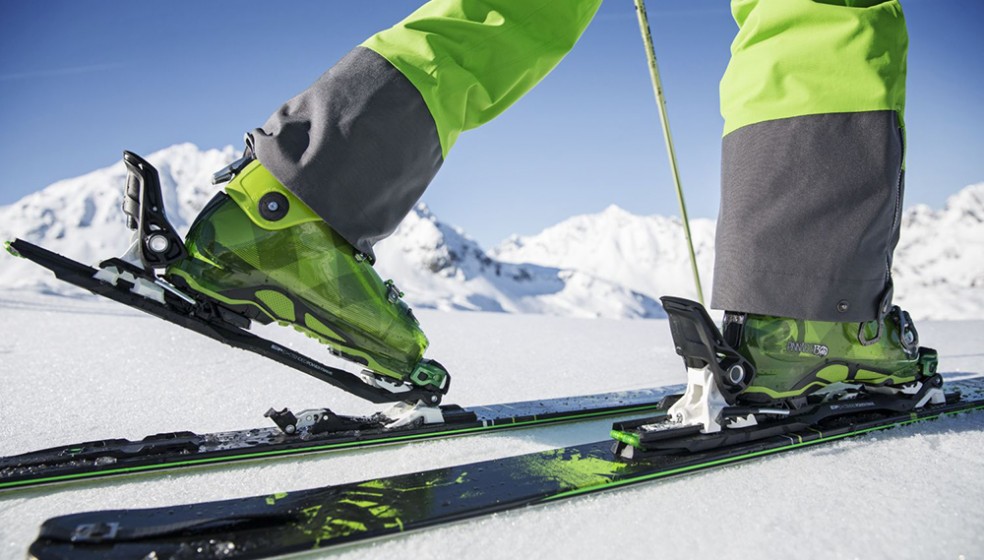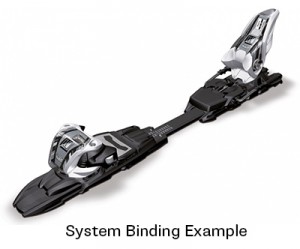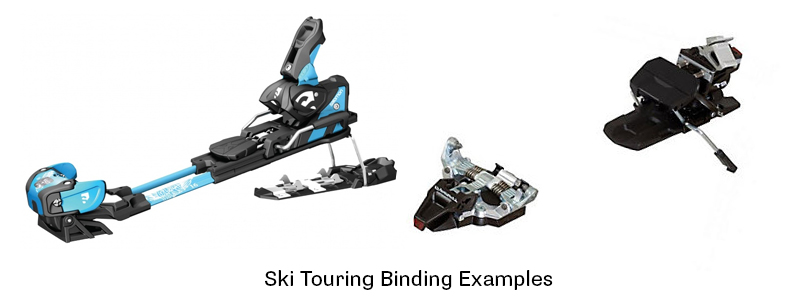Ski bindings are a critical component of a ski which need to perform two equally important functions:
- The binding must solidly connect a ski boot to a ski to allow the skier to precisely control their ski
- The binding must release the boot to protect the skiers legs and ankles from damage when control of the ski is lost
There are several different categories of ski bindings:
System bindings – some skis are sold with a binding system built into the ski and these are often called system bindings (or integrated bindings). System bindings are thus not usually sold separately but come as part of the ski package. Most on-piste skis and many high performance all-mountain skis are sold with system bindings included.
All mountain bindings – many all-mountain skis are sold without a binding. For these skis you select a bindinSki Bing specific to your ski style and DIN required. If you are a heavy skier and/or you ski aggressively, then a binding with a higher DIN range (greater than 10) may be required. You should also steer clear of lighter weight bindings and look for bindings with beefy construction and materials.
Freeride/Freestyle Bindings – most free-ride and freestyle skis are sold without a binding. You select a binding specific to your ski style and DIN required.
Childrens bindings – These are designed to fit junior ski boots and feature lower DIN settings than adult bindings and a lighter construction to make them most suitable (and more affordable) for the lightest skiers.
Touring Bindings: Ski touring bindings allow the heel to raise off the ski while the toe remains fixed on a pivot. This allows the skier to skin up hill in a near normal walking motion. Touring bindings are available in lightweight tech options, or can be a more traditional free-ride design.
Key ski binding terminology explained:
DIN settings – What does the DIN setting mean? It is a very common question and DIN stands for Deutsches Institut für Normung (German Institute for Standardization) and is the industry standard scale for release force settings for ski bindings. Skis act as huge levers on the skiers joints and ski bindings are designed to release the skis from the boots if the forces transmitted through them exceed that which the skiers anatomy can cope with. Essentially the DIN setting numbers on a binding are a measure of how easily the binding releases the boot. Heavier skiers and those who ski aggressively require higher DIN settings to keep the boot in the binding. Beginners, lighter skiers, older skiers and those who ski at slower speeds require a lower setting. These settings are selected from a chart and this should only be done by an experienced ski technician based on the skiers height, weight, ability and boot size. DO NOT change DIN settings your self unless you know what you are doing, over tightening DIN settings could result in serious injury. If in doubt ask the friendly staff at your local ski shop.
Brake width – The brakes on the binding you select need to be at least as wide as the width of your ski at the ski waist (narrowest part of the ski under foot) . Don’t go more than say about 10mm wider though or the brake will drag in the snow when you have the ski on edge in a turn. So for example, a 90mm brake on an 80mm waist ski is okay, but a 115mm brake on a 80mm waist ski is definitely too wide.
Care of bindings:
There are no user serviceable parts on a ski binding and if properly cared for they are maintenance free and will last a long time. The main things you can do to ensure long trouble free service are:
- Ensure the bindings are properly set for the length of your boot by a ski technician when you purchase your bindings. If you change your ski boots you need the bindings to be properly set up for your new boots.
- Protect your bindings from dirt. Chucking them on the roofrack and driving up or down a dusty ski-field road or on gritted roads is not recommended. If they must go on the roof, use a ski box or put your skis in a ski bag if they are exposed on racks.
- Don’t powerwash, waterblast or use soapy water to wash dirt out of the bindings if you don’t adhere to 2. above. This will drive dirt deeper into the binding grease and/or wash out the binding grease, neither being a good result. If you need to get rid of dirt, a gentle rinse with cold water is the most you should subject your bindings to.
- Store your skis in a dry environment to allow the bindings to dry after skiing and to minimise rusting of the ski edges.
See you out there,
Ed Liddle
Torpedo7
Dunedin




















